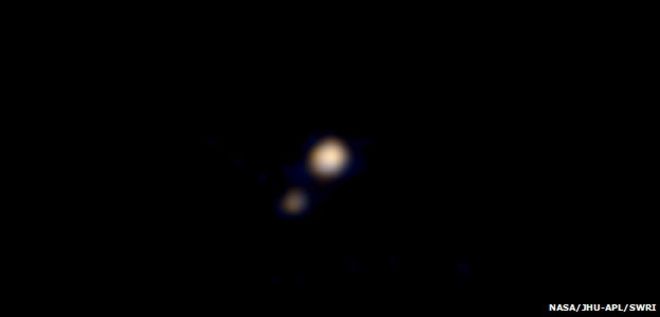

This image? It’s the first color photograph of Pluto ever captured. Currently, this distant, icy world looks like little more than a tiny blob. That’s because New Horizons is still 74.1 million miles (115 million km) from Pluto. If you don’t know, that’s still quite far from the Pluto system. For comparison, the moon is a mere 238,900 miles (384,400 km) from Earth. Plus, the moon is a bit larger than Pluto.
All of this added together means that our images are going to be rather fuzzy for some time. Well, at least for the next 3 months, until the spacecraft rendezvous with Pluto.
And the New Horizons spacecraft is quickly approaching its target. It’s speeding ahead at some 8.6 miles (14 kilometers) every second. At closest approach, New Horizons will soar through Pluto’s system at a speeds reaching 30,000 mph (50,000 kilometers per hour). And as it draws ever closer, Pluto and its five moons will come into view. Then, for the first time, we will truly see the little world at the outer reaches of our solar system.
And did you happen to catch that bit about the moons?
Yes, Pluto does, in fact, have five moons. As NASA pointed out yesterday, New Horizons isn’t just about taking a closer look at Pluto, but all of the objects at the outer edges of our neighborhood: “This mission also opens the door to an entirely new ‘third’ zone of mysterious small planets and planetary building blocks in the Kuiper Belt, a large area with numerous objects beyond Neptune’s orbit.”
Alan Boyle listed a string of potential discoveries that Pluto scientists say may be in store for us:
- New moons to add to Pluto’s known retinue of five, and perhaps rings of icy material as well.
- Clues to the compositional differences between Pluto and Charon — which, like our own moon, is thought to have been formed out of the debris from a planetary crash.
- Nearly global maps of Pluto and Charon, including permanently shadowed polar regions of Pluto that will have to be illuminated for New Horizons’ cameras by Charon’s reflected moonlight.
- Liquid layers that may lie within Pluto and Charon, consisting of water or more exotic materials. “There could be rivers of neon that have been speculated about,” Stern said.

Current estimates assert that New Horizons will fly past Pluto on 14 July. Sadly, it will take us some time to receive these images. At its closest, Pluto is still 2.66 billion miles (4.28 billion km) from Earth. Ultimately, it even takes light a bit of time to travel across this vast distance—it will take nearly 5 hours for radio signals to make it back to us.
So, how good will our images really be?
Ultimately, our maps will allow us to distinguish a number of features. The final images will have a resolution as sharp as a quarter-mile (400 meters) per pixel.That’s definitely enough to distinguish notable structures and attain a comprehensive map. For comparison, if the spacecraft were to fly by Earth, it would be able to clearly see Central Park.
From Quarks to Quasars is two people, Jaime and Jolene. We want to make the world a more sciencey place. We’re doing that, but with your help, we can do even more.
FQTQ takes a lot of time, money, and effort. Here, you can support us, get to know us, and access extra content: